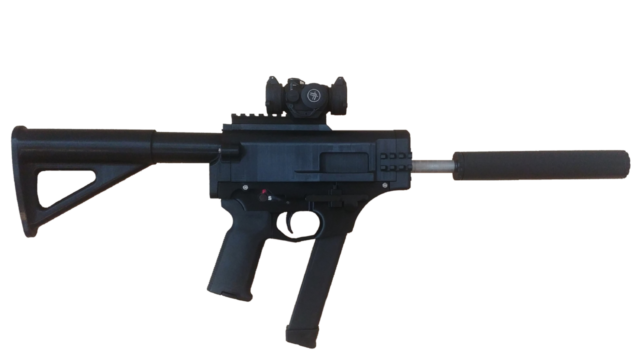
Anti-Junta Rebels Resort to 3D-Printed Weapons in Myanmar
Publication: Terrorism Monitor Volume: 22 Issue: 7
By:

Executive Summary
- Anti-junta rebels in Myanmar are increasingly turning to 3D-printed weaponry to fight the regime’s forces. These weapons are significantly cheaper to acquire and easier to produce than factory-made armaments. Going forward, 3D printers may offer insurgents arounds the world a new means by which to acquire arms which had previously been too challenging to obtain.
- In the Burmese case, 3D-printed guns serve as a way to acquire low-grade weapons if a group has none, which are then used to either train militants or launch hit-and-run attacks on government forces. This latter tactic offers insurgents a chance to pilfer more modern weaponry, which is then used on the frontlines and/or to acquire other, heavier armaments, creating a positive feedback loop.
- 3D printers also offer militants an opportunity to produce cheap drones, bomblets, and other arms that traditionally require conventional supply chains to procure and maintain.
Since 2021, Myanmar has been embroiled in a bloody civil war, following the seizure of power by the country’s military (France 24, January 11, 2022). In the last several years, rebels have resisted the junta’s forces (often termed the Tatmadaw), resulting in many of them resorting to the creation and use of home-made weapons, including 3D-printed firearms (France 24, January 11, 2022; We Are The Mighty, July 25, 2023). The use of 3D-printed weapons by the anti-junta rebels against the Tatmadaw may be a game-changing development for the former in the ongoing civil war.
A Feasible and Effective Solution
The anti-junta rebels lack conventional weaponry (Manufactur3D, August 3, 2023). To get around this, rebel fighters have in some cases taken to using 3D-printed arms to fight the Tatmadaw, pilfer their conventional arms, and seize key junta positions (and accompanying materiel) (France 24, January 11, 2022; The National Interest, January 14, 2022; Wired, September 29, 2023). Many photos have surfaced on the internet which appear to show the rebels armed with 3D-printed firearms, supporting this understanding of the conflict (X/@Jake_Hanrahan, December 9, 2021, January 11, 2022, March 5, 2023). Additionally, several videos appear to confirm the rebels’ use of 3D-printed weapons specifically in combat operations (X/@Jake_Hanrahan, July 20, 2022, May 13, 2023; X/@war_noir, May 12, 2023, July 6, 2023).
In order to produce 3D-printed weapons, one must have both a 3D printer and a model. Models may be found online easily, and the rebels in Myanmar are making use of the most well-known 3D-printed firearms, including the FGC-9 designed by the late “JStark1809,” a celebrity among the 3D-printing enthusiasts (3DPrint.com, November 13, 2023). Allegedly, 3D-printing technology has been hailed as filling a critical deficiency by the rebels (Reddit/@DaddyUMCD, December 13, 2021).
Due to their inability to access factory-produced weapons, rebel fighters have also benefitted from alternative manufacturing processes that allow them to produce time- and cost-effective 3D-printed weapons (France 24, January 11, 2022). For example, beyond the cost of the 3D printer itself, an FGC-9 can be produced for less than $500 in roughly a two-week period (We Are The Mighty, July 25, 2023). Moreover, the production of 3D-printed firearms does not require full-scale manufacturing, thus enabling the rebels to produce them on their own in small workshops or in bases close to the battle. The decentralized nature of the internet and the affordability of desktop 3D printers has further allowed the rebels to equip themselves and mass-produce rifles, even in the absence of factory-produced firearms (Manufactur3D, August 3, 2023).
Although only a few combat operations have actually been conducted with 3D-printed guns, they still feature prominently in hit-and-run missions, which are aimed at capturing more advanced weapon systems from the Tatmadaw (France 24, January 11, 2022). Therefore, firearms such as the FGC-9 are considered by the rebel fighters as a vital, yet inexpensive, way to reinforce their armaments. To reiterate, the main use of the 3D-printed arms is to offer the rebels a sort of intermediary form of weaponry, allowing them to seize factory-produced weapons, which are still preferred in combat operations. While 3D-printed weapons are not as effective as factory-produced weapons, they also can be useful in training inexperienced fighters, allowing the scarce factory-produced arms to be kept for frontline militants.
Conclusion
It is not unlikely that there will be a further expansion of the use of 3D-printing technology by rebels in Myanmar. Parts of drones, such as their frames, are also being 3D printed directly by the rebel fighters (Wired, September 29, 2023). Images which appear to show anti-junta fighters using combat drones comprised primarily of 3D-printed components exist. The model, termed the Liberator-MK2, allegedly only requires several days to produce (X/@PopularFront, June 22, 2023). Additionally, rebel fighters can use 3D printers to produce small bombs which can be dropped from quadcopter drones. Therefore, 3D manufacturing enables insurgent groups to use drones even if they are unable to access conventional supply chains for civilian- or military-grade weaponry.
The case of Myanmar’s anti-junta fighters more broadly shows how 3D-printing technology can become a crucial tool in producing weapons for militants. Lacking access to conventional firearms, Myanmar’s rebels creatively turned to 3D printing to fight the junta. They used cheap and easy-to-produce guns, such as the FGC-9, to employ in hit-and-run operations and train their fighters. What is currently occurring in Myanmar may prove to be a sign of things to come with regard to the future of asymmetric warfare.



